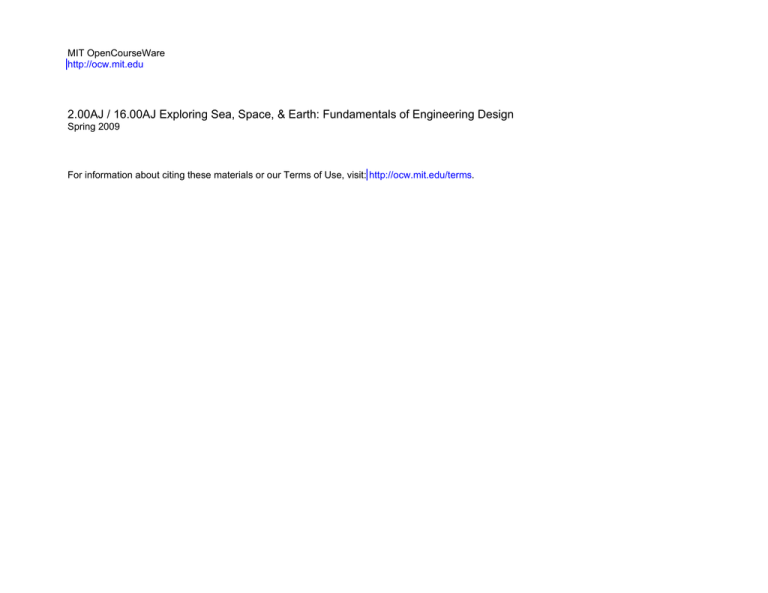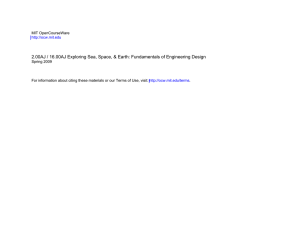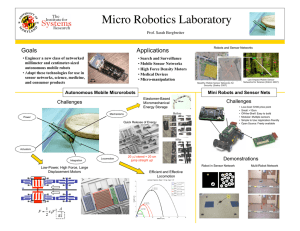2.00AJ / 16.00AJ Exploring Sea, Space, & Earth: Fundamentals of... MIT OpenCourseWare rials or our Terms of Use, visit: .
advertisement

MIT OpenCourseWare http://ocw.mit.edu 2.00AJ / 16.00AJ Exploring Sea, Space, & Earth: Fundamentals of Engineering Design Spring 2009 For information about citing these materials or our Terms of Use, visit: http://ocw.mit.edu/terms. Designing an Underwater ROV Purpose Performance The purpose of our project was to design and construct an underwater remotely-operated vehicle to maneuver in the Charles River while using a sensor package to take data. The vehicle needed to be able to move in all six directions (forward, backward, up, down, left and right). The sensor package needed to measure temperature, conductivity, light and pressure. 2.00A/16.00A Final Project o Was not completely balanced. o Would tilt to one side when going forward/backward. o LEDs not powerful enough to see underwater o Sensor package container leaked after certain depth was reached. o Took a long time for vertical motor to bring ROV back to surface. Results Design The results that the sensor package gives are in Volts and must be calibrated. •Center left mostly empty to create less drag. •Placed camera/LEDs as to cancel out weight of motors. •Added 2 buoys symmetrically about central axis. Below is the graph of the four readings that the sensor took progressively over time. There is a clear inverse correlation between conductivity and light, which makes sense because when the package is in the water there is very little light but high conductivity. As is illustrated in the table, the temperature readings only make sense if temperature is lower with higher voltage, because otherwise the water would be warmer than the air. In the water the average conductivity was measured to be 1.49 S/m, and the average temperature if we do not take into account inverse correlation was 23.67 degrees Celsius. •Drilled holes in bottom pipes and central pipe. •Needed one 2g weight attached to the front to achieve level motion. Working on the vehicle at the docks. •Sealed off top front/back pipes to achieve the final desired balance. Process • •Used hose-tie configuration to attach central motor. Considered multiple ideas while brainstorming. Original Vehicle Design: This design is different than our final design in that our final design has no instrument panel, has the back motors attached differently, and has the sensor packet above the motor. • Chose a simple, rectangular box design in order to minimize problems and other complications. • Chose motors based on data obtained from experimentation: Propeller Type Motor (gal/min) Force (g) Volts (V) Amps (A) 3 blades 500 140 - 200 12 4.5 2 blade black 500 140 10 4.5 2 blade black 750 200 4.6 4 2 blade gray 500 med. 270 10 4.5 Cons: Pros: • Easy to build • Simple design with few things to go wrong • Horizontal motors can be moved around to different angles to achieve desired power and turning speed. • Difficult to achieve desired balance between front and back. • Graph of data collected by the four sensors. Lacks desired power for vertical motion. Reading(V) Position Out of Water In Water Conductivity Temperature 0.89 336.17 1337.85 1370.37 Light 89.49 0 Pressure 142.13 110.07 Conductivity(S/m) 0.004 1.49 Approx. Value Temperature ( C) 16.67 23.67 Depth(m) Light(Lux.) 0.21 -0.1 -113395 -2887.42 Table of Average Collected Voltages and Average Estimated Values. Results from motor testing. • Wanted motors that weren’t too powerful to allow for easier control. • Thought that vertical motion would require more power. • Originally planned to use two 500 gal/min motors with black propellers to control horizontal motion and one 750 gal/min motor with a gray propeller to control vertical motion. • Had to change vertical controller to a 500 gal/min motor with a black propeller. o Challenge to attach gray propeller was not outweighed by its greater power. o 750 gal/min motor was faulty. • Planned to attach weighs/buoys and drill holes in PVC as needed to achieve neutral buoyancy. Construction: Our data is not very accurate because many of the sensors were fairly faulty. It is also difficult to make an accurate conversion from the voltages to the actual surrounding conditions. For example: we planned on calibrating the pressure sensor based on a certain measurable depth. This failed, because the pressure sensor did not change its values depending upon its location. •We built the frame out of PVC pipe •We attached the components with hose clamps and zip ties. •The motors were attached with metal fasteners. Reflections •Holes were drilled in the PVC so that water could flow in to keep constant buoyancy. Finalized vehicle in the water at the docks. The vehicle performed overall as we planned it to. However, we had a number of difficulties with the sensor package, such as leaking, breaking components (the temperature and light sensors.) It would have been helpful to know in advance that we should attach things with long wires. We also had some problems with the propellers falling off even when they were glued on, and one of our motors was faulty. Our vehicle did not go as fast as many of the others, so it might have been better to go for a smaller more maneuverable design.





